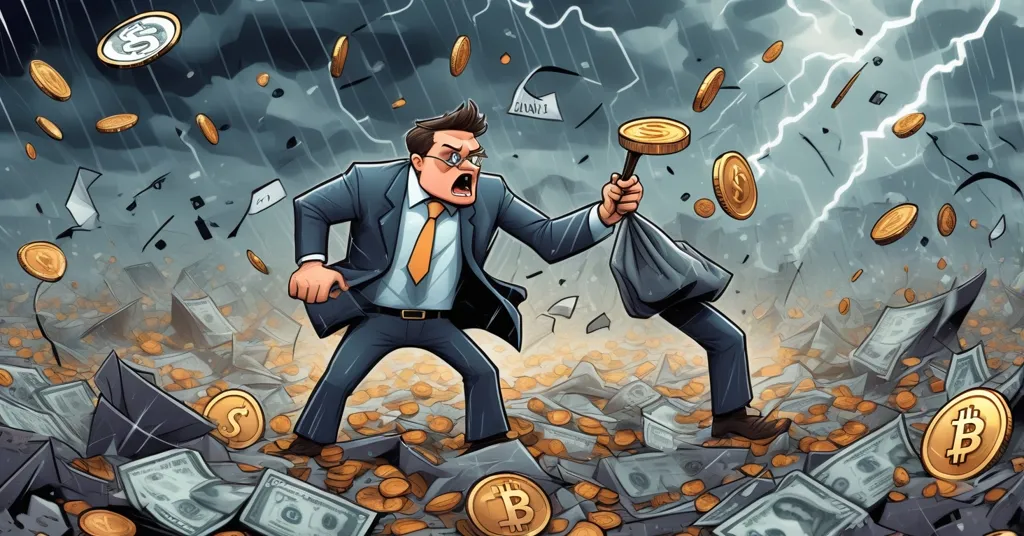Crypto Crash: Are Sub-$1 Altcoins Like $ONDO and $HBAR Worth the Risk?

Brutal Crypto Crash: Are These Sub-$1 Altcoins Worth Betting On?
The crypto market has been hammered relentlessly in recent weeks, with valuations plummeting and investor confidence shredded. In the aftermath of this carnage, bargain hunters are scouring the wreckage for sub-$1 altcoins, hoping to snag the next big rebound. But is this a strategic move or just a desperate gamble?
- Market Meltdown: A vicious downturn has gutted crypto valuations, sparking a frenzy for cheap altcoins.
- Sub-$1 Focus: Examining four altcoins under $1—Ondo Finance ($ONDO), Hedera ($HBAR), Stellar ($XLM), and Jupiter ($JUP)—for potential value.
- Hype Warning: Cutting through psychological traps like unit bias to focus on hard fundamentals and real risks.
Setting the Scene: Why Altcoins Get Crushed Harder
Before we dive into specific projects, let’s zoom out. This market crash isn’t just a random blip—it’s a brutal reminder of crypto’s volatility, often driven by macroeconomic pressures like rising interest rates, regulatory crackdowns, or Bitcoin sell-offs cascading through the ecosystem. Altcoins, with their smaller market caps and thinner liquidity, typically suffer more than Bitcoin during these storms. While Bitcoin’s network effect and security make it a relative safe haven, altcoins can tank 50-80% overnight, leaving latecomers holding empty bags. Yet, crashes also unearth opportunities for those with guts and due diligence. So, which sub-$1 altcoins are showing signs of life amidst the rubble? I’ve zeroed in on four projects with intriguing fundamentals—and equally glaring risks. Let’s break them down.
The Mental Trap: Understanding Unit Bias
First, a critical pitfall to sidestep. There’s a sneaky psychological bias called unit bias that lures investors into thinking low-priced tokens—say, under $1—are inherently “cheap” or a safe bet. As one savvy observer nailed it:
Most people see altcoins under $1 and think it’s ‘cheap.’ There’s a strange comfort in buying something under $1. It feels safer. It’s like there’s less to lose. It’s called unit bias. But that mindset can blind you from what actually matters.
Here’s the rub: a token at $0.50 with a billion in circulation isn’t cheaper than one at $100 with a million. Market cap, token supply, and project traction matter far more than the sticker price. Unit bias is a rookie mistake, especially in a bear market where emotions run high. Our mission is to focus on substance over illusion, so let’s judge these altcoins by their merits, not their pennies.
The Sub-$1 Contenders: Worth the Risk?
Ondo Finance ($ONDO): Leading the RWA Charge?
Starting with Ondo Finance ($ONDO), currently priced at $0.59, this project is a frontrunner in the Real-World Asset (RWA) sector. RWAs involve tokenizing traditional investments—like real estate, bonds, or stocks—on a blockchain, making them easier to trade or split into fractions. Ondo’s metrics are impressive: a Total Value Locked (TVL) of $1.8 billion, meaning that’s the total worth of assets staked or secured in their protocol, a key gauge of adoption. Their daily trading volume tops $8 million, with fees ranging from $69,000 to $230,000. Their latest innovation, Ondo Global Markets, enables on-chain trading of over 100 stocks, with ambitions to hit 1,000. But there’s a snag—it’s restricted to institutional players for now, locking out retail investors like you and me. Still, the potential is massive, as one analysis pointed out:
The RWA sector is bound to grow to around $16 trillion by 2030. However, the $ONDO price is lagging behind.
Even with conservative estimates pegging RWAs at $16 trillion by 2030 (and wilder ones at $68 trillion), Ondo’s price hasn’t caught up to the hype. A Bitcoin maximalist might argue that RWAs are a distraction from BTC’s pure store-of-value mission, but I see value in altcoins tackling niches Bitcoin ignores. That said, a yearly token unlock in early January looms large. For the uninitiated, token unlocks release previously restricted coins into circulation, often sparking sell pressure if holders dump—think of it as a company issuing new shares, diluting value unless demand surges. Can Ondo’s fundamentals outweigh this risk, or is this just an institutional playground for now?
Hedera ($HBAR): Could ETFs Spark Scarcity?
Next, let’s look at Hedera ($HBAR), trading under $1 (exact price fluctuating as of this writing). Built on Hashgraph technology—a distinct alternative to standard blockchain promising faster transactions and lower energy use—Hedera is making waves with institutional adoption. The Canary Spot ETF already holds nearly 1% of the total $HBAR supply, with 14 more ETFs in the pipeline. Consistent inflows into the Canary fund could lock up significant portions of circulating tokens, potentially driving scarcity and price appreciation if demand holds. One voice in the space underscored this shift:
$HBAR has well and truly entered the ETF era… That single fund already holds nearly 1% of all HBAR.
On the tech front, Hedera launched Agentic DeFi, letting users execute trades or set conditional orders using natural language through their Agent Hustle UI—imagine telling your wallet, “Buy $HBAR if it drops to $0.05,” and it just happens. Last October, $HBAR spiked 8x, likely fueled by market momentum or partnerships, though there’s no guarantee of a repeat in today’s dour climate. Compared to Bitcoin’s battle-tested resilience, Hedera’s reliance on ETF adoption feels like a gamble—regulatory hurdles could stall progress. Still, if you’re betting on institutional money flooding crypto, is this altcoin a dark horse?
Stellar ($XLM): Building Bridges Across Chains
Stellar ($XLM), sitting at a dirt-cheap $0.025, is quietly positioning itself as a powerhouse in cross-border payments and RWA tokenization. Recently, they teamed up with Turbo Energy, a Nasdaq-listed solar/storage company, and Taurus, an infrastructure provider, to tokenize debt financing for hybrid solar-battery projects in Spain. This isn’t just theoretical—it’s tangible impact. Stellar’s integration with LayerZero Labs connects them to over 150 blockchains, facilitating $38 billion in cross-chain transactions last month alone, a staggering volume compared to prior quarters and a sign of growing momentum. As one insider framed it:
Stellar isn’t just a single-chain solution. Instead, it is positioning itself as a glue layer in multichain value movement.
The Stellar Development Foundation reported robust growth in RWAs, DeFi, and developer activity for Q3 2025. From a decentralization standpoint, Stellar’s challenge to traditional banking via low-cost transfers aligns with disrupting the financial status quo, though Bitcoiners might scoff at anything less decentralized than BTC. A word of caution: at such a low price, recovery depends on market sentiment flipping bullish, and cross-chain reliance could backfire if a connected network gets hacked. Does Stellar’s practical value outweigh these pitfalls?
Jupiter ($JUP): DeFi Dominance on Solana
Rounding out the list is Jupiter ($JUP), priced at $0.29, a heavyweight in DeFi on the Solana blockchain. Boasting a TVL of $3.1 billion—nearly 30% of Solana’s total—Jupiter is a dominant force. Their Ultra V3 upgrade, featuring the Iris router, delivers sharper pricing and a jaw-dropping 34x better protection against sandwich attacks. For the unversed, sandwich attacks are a dirty trick where bots place trades before and after yours to manipulate prices and siphon profits. One enthusiastic take summed up the upgrade:
Jupiter Ultra v3 is basically Godmode on-chain… Protected transactions with 34x less sandwich attacks than top trading terminals.
Adding fuel to the fire, the Jupiter community voted with 86% approval to burn 130 million $JUP tokens—4% of circulating supply—to curb sell pressure. Token burns permanently destroy coins, often seen as bullish if demand stays steady. Burning 130 million tokens? That’s one way to light a fire under a bear market. While Bitcoin doesn’t dabble in DeFi, Jupiter proves altcoins can dominate spaces BTC doesn’t touch. Yet, Solana’s own volatility could drag Jupiter down, fundamentals be damned. Is this DeFi giant a safe bet, or just another Solana casualty waiting to happen?
Risks to Watch: Why Sub-$1 Altcoins Can Be a Trap
Stepping back, let’s not drink the Kool-Aid just yet. These altcoins showcase innovation—Ondo’s RWA leadership, Hedera’s ETF potential, Stellar’s cross-chain prowess, and Jupiter’s DeFi dominance—but the market is a slaughterhouse right now. Here are the collective red flags: token unlocks like Ondo’s could flood supply, regulatory uncertainty around ETFs could derail Hedera, cross-chain dependencies for Stellar risk cascading failures, and Jupiter’s fate is tied to Solana’s rollercoaster. Broader issues plague low-priced altcoins too—market manipulation, rug pulls, and the harsh reality that most fail to recover post-crash compared to Bitcoin’s proven grit. I’m all for accelerating a decentralized future, but blind optimism is a one-way ticket to zero. Buying dips works only if you’re backing projects with staying power, not just cheap tags.
DIY Research: How to Vet Altcoins Yourself
For those eager to hunt beyond these four, arm yourself with tools to separate wheat from chaff. Check whitepapers for a project’s vision and tech—vague promises are a red flag. Scope out GitHub activity to see if developers are actually building, not just hyping. Join Discord or Telegram communities to gauge sentiment, but beware echo chambers. Platforms like CoinGecko or DeFiLlama offer hard data on market cap, TVL, and tokenomics. Most importantly, ask: does this solve a real problem Bitcoin can’t? If not, it’s likely just speculative noise—and in crypto, noise gets drowned out fast.
Key Questions and Takeaways
- What is unit bias, and why should crypto investors avoid it?
It’s the flawed notion that low-priced tokens are “cheap” or safer, ignoring critical metrics like market cap or utility. This mindset can lead to disastrous picks, especially in volatile crashes. - Does Ondo Finance ($ONDO) have potential despite short-term risks?
With $1.8 billion TVL and a foothold in the $16 trillion RWA future, Ondo’s fundamentals are strong, but token unlocks in January could spark sell pressure. - How might ETFs shape Hedera’s ($HBAR) trajectory?
The Canary Spot ETF and 14 pending funds could lock up supply, boosting scarcity and price if demand holds, though regulatory risks loom large. - What sets Stellar ($XLM) apart from other cheap altcoins?
Stellar’s $38 billion in cross-chain transactions and RWA tokenization for solar projects show practical impact, though its recovery hinges on market sentiment. - Is Jupiter ($JUP) a DeFi standout worth considering?
Dominating Solana with $3.1 billion TVL, cutting-edge Ultra V3 upgrades, and a token burn, Jupiter shines, but Solana’s volatility is a constant threat.
Final Thoughts: Balancing Risk and Revolution
Navigating this crypto bloodbath demands steel nerves and a sharp mind. These sub-$1 altcoins tempt with innovation and low entry points, but crypto rewards skepticism as much as boldness. As a Bitcoin maximalist at heart, I’ll always lean toward BTC’s unmatched security and decentralization—altcoins are often speculative side bets by comparison. Yet, I can’t deny the niches they fill, from DeFi to RWAs, pushing boundaries Bitcoin doesn’t. If we’re accelerating toward a decentralized future, betting on underdog altcoins isn’t just speculation—it’s rebellion. Just ensure you’re backing the right rebels. Stick to fundamentals, sniff out scams, and remember: in crypto, dips can always plunge deeper.



